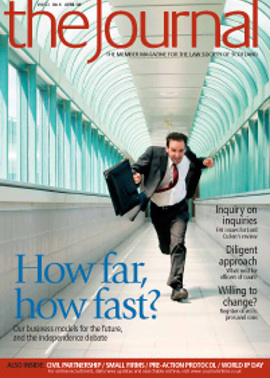Another ***** meeting?

As a solicitor you will find yourself in meetings, whether with clients, between the parties to a dispute and their representatives, with colleagues, partners or members of staff. Frank Snell, author of How to Win the Meeting states that executives spend 75% of their time in meetings, and 67% of those surveyed by a leading consultancy believed they would attend more meetings in the coming year than in the previous year.
Despite this, if I were to ask you to complete the statement in the title, I venture to suggest, and with some confidence, that the words that spring readily to mind all have one thing in common – their negative connotations. “Boring”, “awful”, “pathetic”, and “wasteful” are a few of the more printable suggestions.
J K Galbraith suggests a meeting is “indispensable when you don’t want to do anything”, and Nicky Stanton describes a meeting as “a group of people who keep minutes and waste hours”. So why the negativity?
Meetings are not the problem. Research suggests that individuals are more committed to a decision in which they have participated, and groups tend to make better decisions than individuals. The problem lies in how they are conducted. Common complaints include participants turning up late, individuals being ill prepared, a weak chairperson and poor decision-making. These negative effects are directly related to an inability to stage and run a meeting effectively.
Before I review the four key stages in creating and conducting an effective meeting and then, briefly, the role of the chairperson, I should begin by offering a definition. I define the purpose of a meeting as being “to arrive at a decision upon which action or actions can be taken”. This forms the foundation on which this article rests.
STAGE 1: PLAN
In the words of Mark McCormack, “People don’t plan to fail, they fail to plan”. Planning is the natural first step and requires the following to be addressed:
Objectives
Clear and unambiguous objectives allow those participating in the meeting to focus their energies on achieving those objectives rather than indulging in what might be better described as group therapy.
Is a meeting necessary?
Is a meeting the best means of arriving at a decision? Alternatives might present themselves, such as the internet, the telephone and the fax machine, that are more effective in terms of time, money and personal commitment.
Who should attend?
Only those who are directly involved in the decision or are influenced by the decision should be asked to attend. These individuals must have the authority to commit their department or organisation to whatever course of action is decided on at the meeting.
Agenda
Setting an agenda is crucial to the success of any meeting. A common form of agenda is one which details the location and time of the meeting together with the name of the chairperson and the names of those scheduled to attend. There then follows a list of bullet points highlighting the issues to be discussed. However, a bullet point such as “Improving the communication process within the firm” might be interpreted differently by different people. For some it might be read as the need to develop a training programme; for others the need to install a sophisticated IT system. Such an approach only serves to confuse, waste time or misdirect effort and should be avoided.
For an agenda to be effective, it must define the topic and direction of the discussion and the end purpose.
For example:
The topic – “Improving the communication process within the firm”
The direction – “Review the following subjects for incorporation in the communication skills training programme”
The end purpose – To select four subjects to form the basis of a core syllabus.
Time is a scarce commodity. It is therefore imperative that it is used to best effect. Allocate a specific timeframe to discuss each item on the agenda, with key issues being allotted the most time. A clear and unambiguous agenda accompanied by an appropriate timeframe in which to debate each issue will contribute towards this limited resource being used effectively.
To further maximise the use of time it is important to consider setting out in the agenda, criteria against which each decision will be made. This allows those scheduled to attend the meeting to focus their efforts on areas pertinent to the decision-making process prior to the meeting, and defines the scope of the discussion during the meeting itself. In addition, deciding how a decision will be reached, e.g. majority vote, unanimity or by one or two individuals will not only ensure the time available is used effectively; it will also inform those attending of their role in the decision-making process and how they might influence that process.
Anticipate all the supporting information that will be needed to ensure the fullest discussion of each point on the agenda and make sure this is available to all participants in advance of the meeting.
STAGE 2: INFORM
Having planned the meeting, the next step is to inform those scheduled to attend. Participants must be given sufficient time not only to read and digest the supporting documentation but also to conduct their own research.
STAGE 3: STRUCTURE
For a meeting to be effective it must have a structure. While the order of the topics under discussion will be determined by the agenda, each should be addressed in these stages:
- State the proposition.
- Produce the evidence.
- Listen to the arguments based on the evidence.
- Evaluate.
- Make a decision which will determine the action to be taken.
The structure of each topic for discussion should follow the above stages to ensure that those participating in the meeting have full confidence in the decisions made. Evidence must come before interpretation and the interpretation must come before the decision.
STAGE 4: SUMMARISE AND RECORD
As a decision is made and a course of action decided, the chairperson should summarise what has been decided and ensure that it is recorded, together with the details of any individual involved in ensuring implementation. Any timeframe for action or requirement for those involved to report back to the group should also be recorded.
Counting the cost
While it is fairly common for meetings to be criticised as a waste of time, it is less often noted that they can also be a significant waste of money.
An investigation into the efficiency and effectiveness of a committee operating in the public sector displayed some alarming cost implications. Based purely on salaries it was discovered that every meeting cost approximately £2,600. This committee was one of 40 created to deal with a particular speciality. Each met, on average, four times a year, had 10 members and meetings lasted on average four hours. This equated to a spend of £416,000 per year – and that was only the wage bill.
An audit of the minutes was sufficient to show that these meetings did not represent value for money. Decisions were not being implemented; some matters sat on the minutes for several months before any action was taken. In other cases, the participants avoided making a decision by setting up subcommittees. A regular audit of all an organisation’s meetings will highlight the meetings which fail to perform and allow the firm to address the problem.
The key role
The chairperson is responsible for, amongst other things, ensuring everyone is in possession of all the relevant information prior to the meeting, organising the venue, presiding over the meeting, maintaining order, defining the limits of the discussion, encouraging individual participation, stopping talkative participants and avoiding any digression. A tall order; indeed a major reason why people don’t like meetings has to do with the selection of the chairperson.
A sense of purpose needs to be created quickly and this will be achieved by an effective chairperson, who:
- Not only emphasises the need to start and finish on time but ensures the meeting does just that. People will be more willing to attend and contribute. Initially, this might mean the team not addressing all the issues outlined on the agenda, but in time the participants will realise the need to use the time available to full effect.
- Provides the group with its terms of reference, i.e. the objective of the meeting, the order of business and how the meeting is to be structured and conducted.
- Introduces each topic, emphasising the time available, the criteria against which a decision will be taken and how that decision is to be made.
The chairperson will then invite debate and ensure that all those attending are fully involved and allowed to contribute their thoughts, ideas and opinions freely.
They should ensure that those talking are listened to without interruption, that the evidence is fully evaluated and that the decision reached is based on the evidence and its proper evaluation.
As decisions are reached on each issue the chairperson should summarise these before moving on to the next issue. This helps to eliminate the potential for misunderstanding by ensuring the group is in full agreement before bringing closure to one issue and opening and debating another.
Summary
A meeting is a forum in which groups make decisions. As individual roles and responsibilities become more specialised, so the number of meetings will increase, and without a conscious overhaul of how businesses organise and conduct meetings the level of dissatisfaction will only increase.
The four stages – plan, inform, structure and summarise – provide a structure designed to ensure that the right decision is taken in a timely and cost effective manner, and regular audits will ensure that meetings represent value for money.
While these may require changes to current procedures, the most important issue in the majority of cases lies with the choice of chair. Seniority should not be the sole criterion and serious consideration should be given to training individuals so that they perform effectively in this very demanding and stressful role.
John McKinlay BA MBA LLM MCIPS ACIArb is Director of Managing Negotiations Ltd
t: 01324 625632
In this issue
- Legal aid in children's hearing referrals
- Still waters run deep
- Catch-up or patch-up?
- Legal science or law-lite?
- Heads above water
- Your name on file
- A welcome addition
- Another ***** meeting?
- A neglected asset
- Planning a year of action
- The Pagan mission
- A good case to read
- Jurisdiction: dispelling the myth
- That special something
- The art of cashing in
- Scottish Solicitors' Discipline Tribunal
- Website reviews
- Book reviews
- In on the Act
- Keeper's corner






